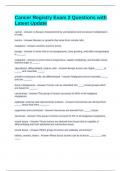Cancer Registry Exam 2 Questions with
Latest Update
cancer - Answer-A disease characterized by unrestrained and excessive multiplication
of cells.
tumors - Answer-Masses or growths that arise from normal cells.
neoplasm - Answer-Another word for tumor.
benign - Answer-A tumor that is non-progressive, slow growing, and often encapsulated
is ______.
malignant - Answer-A tumor that is progressive, rapidly multiplying, and invades tissue
beyond origin is _____.
specialized, differentiated, mature cells - Answer-Benign tumors are highly ______ or
_____ and resemble _____.
primitive embryonic cells, de-differentiated - Answer-Malignant tumors resemble _____
and are ______.
three, histogenesis - Answer-Tumors can be classified into ____ broad groups which
are based on ______.
carcinomas - Answer-This group of tumors accounts for 90% of all malignant
neoplasms.
epithelial, external and internal body surfaces - Answer-Carcinomas are derived from
_____ tissue that lines _______.
supportive and connective - Answer-Sarcomas are derived from _____ tissue.
sarcomas - Answer-This group of tumors account for 5% of all malignant neoplasms.
mixed tissue - Answer-These tumors are derived from tissue that is capable of
differentiating into both epithelial and connective tissue.
mixed tissue - Answer-Which group of tumors are relatively uncommon?
kidney, ovaries, testes - Answer-Mixed tissue tumors can be found in ____, ___, and
____.
, bone, muscle, cartilage, fat, fibrous, blood vessel, blood forming, nerve - Answer-
Sarcomas are found in ____, ____, ____, ____, ____, ____, _____, and _____ tissue.
mixed tissue tumor - Answer-A wilm's tumor is classified as a ______.
mixed tissue tumor - Answer-A teratoma is classifed as a _____.
sarcomas - Answer-Leukemia, Hodgkins, non hodgkins, and multiple myeloma are all
classified as ____.
sarcomas - Answer-Neuroblastoma and astrocytoma are classified as _____.
carcinoma - Answer-Malignant melanoma is classified as a ______.
carcinoma - Answer-Seminoma is classified as a _____.
histologic term - Answer-The first four digits of the morphology indicate specific _____.
behavior code - Answer-The fifth digit of a morphology code (after the slash) is the
_____.
malignant, in situ, uncertain, benign - Answer-The behavior code indicates whether a
tumor is ____, ____, _____, or _____.
2, 0, 1, 3, 6, 9 - Answer-Indicate which number corresponds with the specific behavior:
in situ ____; benign ____; uncertain ____; malignant ____; metastatic site ____;
undetermined ____.
well differentiated, differentiated NOS - Answer-Histologic grade 1:_____ or ____.
moderately differentiated, intermediate differentiation - Answer-Histologic grade 2:
_____ or _____.
poorly differentiated - Answer-Histologic grade 3: _____.
undifferentiated, anaplastic - Answer-Histologic grade 4: ____ or _____.
undetermined, not stated, not applicable - Answer-Histologic grade 9: _____, ____ or
____.
t-cell - Answer-Histologic grade 5:
b-cell - Answer-Histologic grade 6:
null cell, non t, non b - Answer-Histologic grade 7: _____, ____, or ____.




